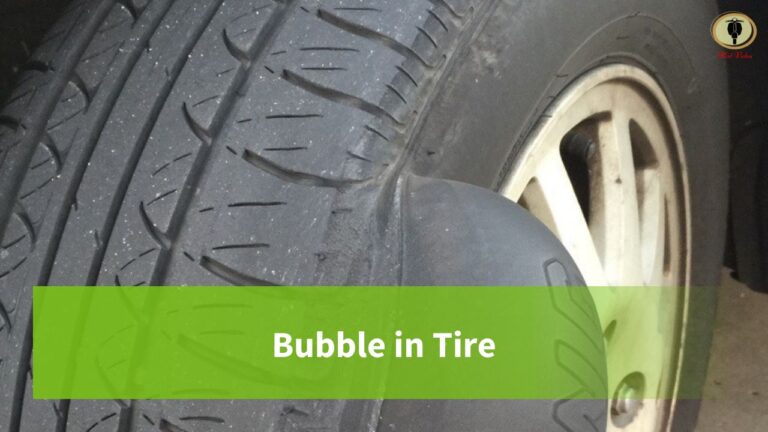If you have a swollen foot, you would likely stop at any given time when you can’t bear the pain. The same goes with your tire. Seeing a bulge in your tire is just a few miles before it will ultimately fail. So, you might be asking: How long can I drive with a bubble in my tire?
If you ask the experts, the answer is NONE. You cannot drive a tire with a bubble in it as it is just a bump away before it blows up. However, it still depends on the condition of the bulge, the road you are taking, and your vehicle’s load. But one thing is sure: It will not go far!
The National Highway Traffic Safety Administration (NHTSA) reports that car tire malfunction is among the top reasons for road accidents, causing fatalities. Don’t be part of the statistics. Read on and learn more about tire bubble and the danger it brings.
What Causes a Bubble in a Tire
A tire bubble occurs typically on the sidewall or around the shoulder. Why does this happen? What causes the swell to appear on the tire’s sidewall?
If your tire swells, it means that the air has escaped from the inside of the tire. This phenomenon usually happens when there is a tear on the inner liner layer of the tire or when there is damage to the sidewall cords.
Your tires may suffer from impact damage from hitting potholes, speed bumps, railroad crossings, and curbs. It is why some people call sidewall swells an “impact bubble.”
Overloading your vehicle may also break the sidewall cords of your tire, resulting in a bubble. Additionally, driving over rough roads or damaged roads could also cause impact damage to your tires, leading to a swelling sidewall.
You may not see the bubble right after hitting a curb or a pothole. However, it soon will slowly develop, and when it appears, you should be ready to get a new tire for safety purposes.
Purchasing a bad tire could also be a possible reason for a tire bubble. If the tire you bought is of low quality or pre-used, this could happen.
A friend of mine bought a new set of budget tires and regretted going cheap with his tires. A week after using them, one of the tires shows some cupping, causing his car to wobble. Then, another tire showed a small lump on the sidewall in about another week. He ended up replacing all four tires.
Bubble in Tire Symptoms
An early symptom of a tire bubble can be the slight wobble you feel when you drive your vehicle. A bulge in the tire is among the many causes of wheel wobble. Thus, when you notice your car is rocking a little, check the condition of your tires.
You can also tell that your tire is about to get a bubble if you start seeing some deformities protruding outward from your tire. When you notice some deformation, it won’t be long for the bulge to appear.
How Many Miles Can I Drive with a Bubble in My Tire?
As pointed out earlier, it is not safe to drive with a tire that has a bubble. Regarding how far you can go with a lump in your tire, this can be subjective as it depends on the severity of the damage. However, it is the safest move if you can do away from driving under this condition.
You would need to go to a tire center for a replacement. If your trusted tire center is relatively far, don’t risk driving your car. It might not go more than a mile before it fails.
If you did your research, you probably see in some forums that some people share that they’ve had a bubble in their tire, and it allowed them to use the vehicle for a while before eventually replacing the tire. Well, good for them. However, in doing so, you are just delaying the inevitable, and I consider it stupid.
Is It Safe to Drive When Your Tire has a Bubble?
I have been reiterating that it is not safe to drive with a tire that has a bubble. Let me elaborate on this to clarify that you should not ignore a bulge in your tire.
When you continue to drive with a bubble in your tire, the air that escapes from the tire’s inner lining increases until the rubber can no longer hold it and explode. Other road factors such as speed bumps, potholes, rough roads could easily trigger the tire to burst.
When your tire blows out, you will lose control of your vehicle and put your life and passengers’ lives on the line. When this happens, your car might also suffer from damage to its wheels and suspension system. So, aside from being unsafe, it is also not economical.
What to Do When You Have a Bubble in Your tire
If you notice a bubble in your tire, you should not ignore it. The first step is to check the severity of the bulge to assess the risk if you continue driving the vehicle for more miles to get to the nearest tire center.
If the bubble is only starting to form or is not huge yet, it may still allow you to drive to a tire shop at a controlled speed. You only need to make sure to avoid hitting another pothole or curb on your way to the shop.
However, replacing the tire is the safest way to go if you have a spare tire in your trunk. With the essential tools like a jack and lug nut wrench, tire replacement is doable on your own.
If you see that the bubble is terrible, like the rubber holding the air is already very thin, you must stop. Get some road assistance if necessary to ensure your safety.
Can You Fix a Tire with a Bubble?
Whichever tire center you go to or whoever mechanic you ask, the answer is NO. When your tire has a bubble in it, that tire is dead. It needs replacement.
Sidewall plays a crucial role in a tire. It provides lateral stability, and it maintains the shape of the tire. When its component is damaged, like broken cords, the tire loses its integrity and could fail at any given time.
If experts don’t even recommend fixing a small hole in the tire’s sidewall, bubbles are not advisable. Simply because it is unsafe, it all boils down to ensuring your road safety.
You will probably find some online resources suggesting that you could fix a tire bubble. Some people explain how installing an internally reinforced patch or sewing the damaged area with a kapron thread would help resolve tire bubbles.
I will not argue with these guys as they have a point. There is always a way to fix things up. But the more significant questions are: Is it safe? Is it the ideal thing to do? Does it guarantee performance? Thus, I insist that you must not attempt to fix a tire with a bubble on the sidewall.
How to Avoid Bubble in Your Tire
As you learned, tire bubbles or sidewall bubbles usually come about due to impact damage. So even though we are careful while driving, unforeseen events will lead us to hit a pothole or a curb.
Now, since we already know that these road factors usually cause tire bubbles, we must avoid them when we can. It can be a challenging job, especially when you drive in the rain and the road floods a little. But under normal circumstances, if you see a pothole, carefully veer away from it.
I would also suggest that you get a set of reliable tires during replacement. Don’t settle with pre-used tires that you can get at a lower price because you will suffer the consequences sooner or later. Go for it if you can afford to get at least the mid-priced tires.
Also, you need to do proper tire maintenance, like checking if the tires have adequate air pressure and checking if rotation is necessary. Among the common reasons our car’s tires will not last long is lack of maintenance. Yes, it is, and I am guilty of it.
Conclusion
A tire bubble is one of the many tire issues you will experience. If you see a lump on your tire, know that it won’t be long until the tire ultimately fails. Check the actual condition of the bubble. See if it can still some more miles for you to go to the nearest tire center for a replacement.
Yes, for a replacement. Unfortunately, you cannot fix the bubble on your tire, or I should say, you must not fix it. It is not worth trying to fix it. Love your life and the life of your passengers by going with the safest solution of replacing the tire.


Great information very specific regarding what yo need to do to address the bulg.